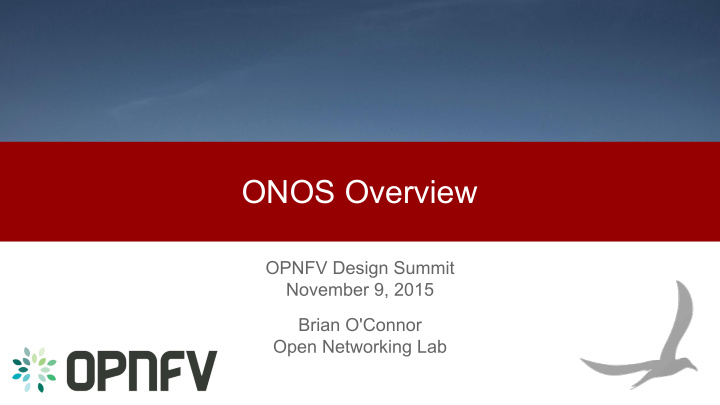



ONOS Overview OPNFV Design Summit November 9, 2015 Brian O'Connor Open Networking Lab
What is ONOS? Open Network Operating System (ONOS) is an open source SDN network operating system. Our mission is to enable Service Providers to build real SDN/NFV Solutions. ONOS Framework (ONOSFW) is the OPNFV project focused on ONOS integration. It is targeted for inclusion in the Brahmaputra release.
ONOS Ecosystem VENDOR ON.LAB SERVICE PROVIDER COLLABORATORS COMMUNITY PARTNERS PARTNERS
Quarterly Releases ● Avocet (1.0.0) released in December 2014 ○ Initial release of clean & modular code-base, protocol independence ● Blackbird (1.1.0) released in March 2015 ○ Improved performance, scale-out, increased robustness ● Cardinal (1.2.0) released in June 2015 ○ New use-cases, additional core features, additional SB protocols ● Drake (1.3.0) released in September 2015 ○ Platform enhancements, security features, UI enhancements ● Emu (1.4.0) - currently in progress for December 2015 ○ Dynamic cluster scaling, Virtual Network and CORD features
Architectural Tenets ● High-availability, scalability and performance ○ required to sustain demands of service provider & enterprise networks ● Strong abstractions and simplicity ○ required for development of apps and solutions ● Protocol and device behaviour independence ○ avoid contouring and deformation due to protocol specifics ● Separation of concerns and modularity ○ allow tailoring and customization without speciating the code-base
Distributed Architecture Apps Apps NB Core API Distributed Core (state management, notifications, high-availability & scale-out) SB Core API Providers Providers Providers Providers Protocols Protocols Protocols Protocols
Distributed Architecture Apps Apps NB Core API NB Core API Distributed Core Distributed Core (state management, notifications, high-availability & scale-out) (state management, notifications, high-availability & scale-out) SB Core API SB Core API Providers Providers Providers Providers Providers Providers Providers Providers Protocols Protocols Protocols Protocols Protocols Protocols Protocols Protocols
Core Subsystems External Apps REST API GUI CLI Mobility Proxy ARP L2 Forwarding SDN IP / BGP Packet / Optical . . . Application Security Device Cfg. Discovery Network Virt. Tenant . . . UI Extension Config Storage Region Driver Path Tunnel Intent Statistics Core Cluster Leadership Mastership Topology Network Cfg. Group Flow Objective Packet Event Messaging Graph Device Link Host Flow Rule OSGi / Apache Karaf OpenFlow NetConf OVSDB . . .
Key Northbound Abstractions ● Network Graph ○ Directed, cyclic graph comprising of infrastructure devices, infrastructure links and end-station hosts ● Flow Objective ○ Device-centric abstraction for programming data-plane flows in table pipeline-independent manner ● Intent ○ Network-centric abstraction for programming data-plane in topology- independent manner
Device Protocol Support Included - OpenFlow - 1.0, 1.3+, driver-based pipeline support via Flow Objectives - OVSDB - NetConf - PCEP - TL1 (available from select vendors) Under development - BGP-LS - SNMP (v2c)
Approaches to Virtualization 1. Overlay (implemented) ● OpenStack/Nicira-style virtualization ● Collection of ports with L2/L3/etc. connectivity ● No topology 2. Hypervisor (in progress) ● OpenVirtex-style virtualization ● Virtual topology elements (devices, ports, links) ● No implied connectivity
Overlay Virtualization Neutron Nova L3 Plugin SFC Plugin ML2 Plugin VTN - VTN is a multi-bundle Application Neutron API Distributed - Distributed VTN Store build using VTN store ONOS primitives VTN Manager SFC Manager CORE Overlay Net - Physical and Overlay Network Topology - Flow Rule management Device Link Host (VM) Flow Rule - Full Mesh Overlay network with two (OVS) (VxLAN) variants: Tunnel Packet Stats Master 1. create a full mesh of tunnel ports 2. Create one tunnel port per Provider compute node OVSDB OF1.3 Compute Node Tunnel Ingress Egress Port Port SF Port SF Port External VxLAN VxLAN - Single Bridge (“br-int”) per node OVS (br-int) OVS (br-int) OVS (br-int) Port OVS (br-int) - OF-based L3 Forwarding - ARP proxy on each compute node Service VM VM VM VM DHCP DHCP VM VM (FW) Compute Node Compute Node Network Node
Software Defined Transformation of Service Provider Networks Join the journey @ onosproject.org
Recommend
More recommend